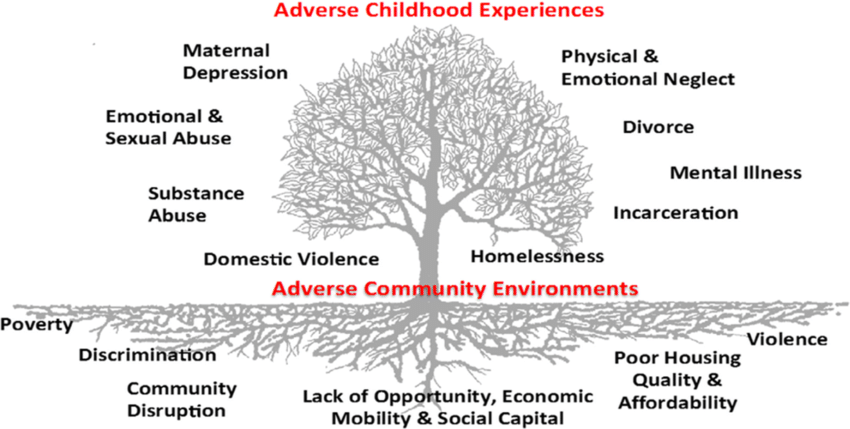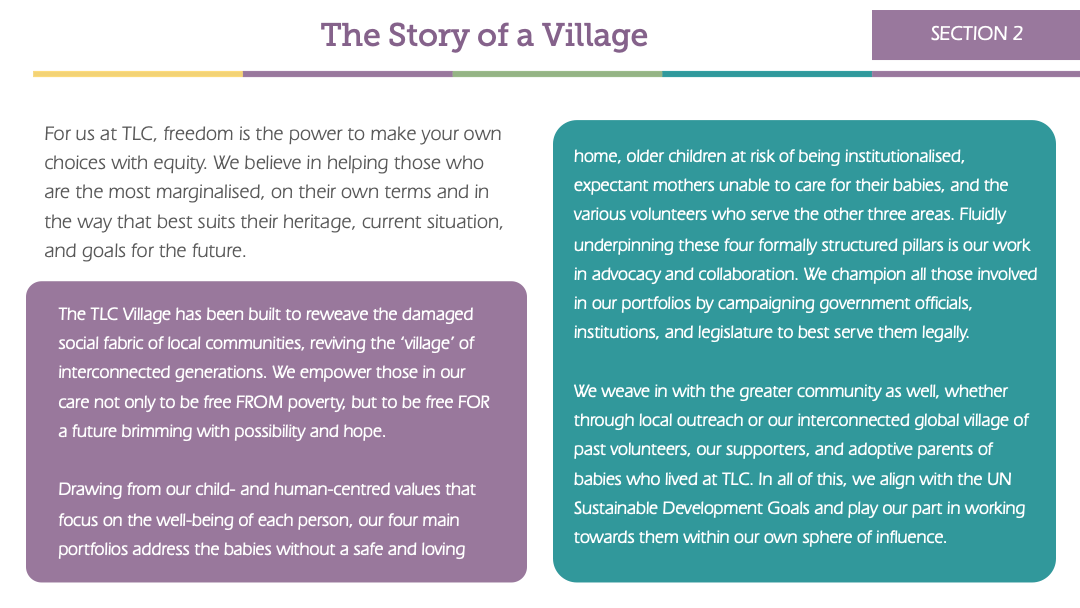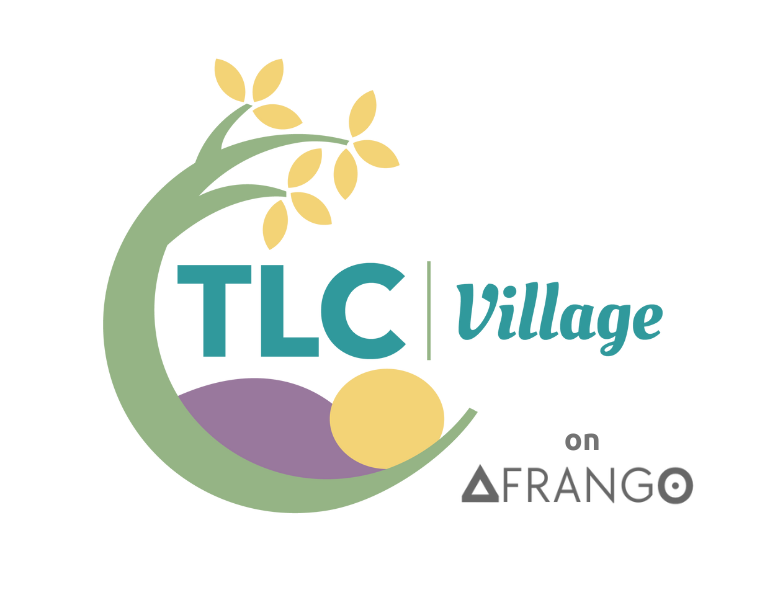ACEs and why they matter
Posted by Breggie Hoffman on 30 May 2022, 12:25 SAST

Authored by Joanna Jones, the Child and Youth Care Centre Manager at TLC Village.

The relatively modern scientific studies of neurodevelopment only began taking shape in the 1950’s when in 1951, John Bowlby (a British psychoanalyst) published his Maternal Deprivation Hypothesis.1
In recent years the field of neurodevelopment and the effects of Adverse Childhood Experiences (ACEs) on the developing brain has exploded. It is critical that those caring for (and responsible for) “children from hard places”, in any capacity, are educated in the implications of this research in order to attempt to mitigate the effect of these experiences on the development and future outcomes for our children.
What are ACEs?
The following quote from the website of the National Conference of State Legislatures (which is an excellent resource on the subject of ACEs and the effects on individuals and communities) defines ACEs as follows… “Adverse childhood experiences (ACEs) are potentially traumatic events that occur before a child reaches the age of 18. Such experiences can interfere with a person’s health, opportunities and stability throughout his or her lifetime—and can even affect future generations.” 2
“ACEs include harms that affect children directly (eg, abuse and neglect) and indirectly through their living environments (eg, parental conflict, substance abuse, or mental illness).”5

Studying Adverse Childhood Events
“The CDC-Kaiser Permanente adverse childhood experiences (ACE) study is one of the largest investigations of childhood abuse and neglect and household challenges and later-life health and well-being.
The original ACE study was conducted at Kaiser Permanente from 1995 to 1997 with two waves of data collection. Over 17,000 Health Maintenance Organization members from Southern California receiving physical exams completed confidential surveys regarding their childhood experiences and current health status and behaviors.”3
The Centers for Disease Control and Prevention (CDC) and Kaiser Permanente questioned participants about “childhood experiences including emotional, physical and sexual abuse; neglect; and household challenges of parental separation, substance abuse, incarceration, violence and mental illness. Nearly two-thirds of participants noted at least one ACE and more than 1 in 5 noted three or more. Researchers identified a link between ACE exposure and a higher likelihood of negative health and behavioral outcomes later in life, such as heart disease, diabetes and premature death.”3
“Moreover, ACEs can follow an intergenerational pattern. For example, research suggests that children who experience physical abuse may be more likely to commit violence, including abusing or neglecting their own children, and to be revictimized in the future. ACEs align with a shifting public health focus to upstream thinking and the prevention of negative behaviors and outcomes before they occur.
Since the original study, the list of ACEs in various measures has expanded with the goal of capturing diverse population data, particularly from children of color and those living in poverty. For instance, since 2011, ACEs questions (In the US) on the National Survey of Children’s Health (NSCH) have incorporated familial death, neighborhood violence, economic hardship and unfair treatment based on race or ethnicity.”3
(Although there have been a number of studies conducted related to the original ACE’s study, details of the original published study are included in the appended references.4)
What are the consequences of ACEs?
ACEs have been linked to immediate and long term consequences for individuals as well as having a notable effect on the economies of the countries where these people reside.
- Consequences of ACEs for the Individual
“The original ACE study2 and decades of research since have linked ACEs to an increased risk of developing chronic diseases and behavioral challenges, including obesity, autoimmune disease, depression and alcoholism. The greater the number of ACEs, the greater the risk5 for negative outcomes. Individuals with multiple ACEs may be more likely to perform poorly in school, be unemployed and develop high-risk health behaviors, such as smoking and drug use. These high-risk behaviors account for nearly 50 percent6 of the increased risk of negative consequences associated with ACEs.”3
A study published in the American Journal of Preventative Medicine states that:
“Two broad mechanisms have been suggested on how ACEs lead to comorbidity in adulthood:
-
delayed consequences of various adverse coping methods such as overeating, smoking, drug use, and promiscuity; and
-
chronic stress mediated by biological reactions.
Based on the life course perspective, ACEs exert their influence by:
-
decreasing optimal growth during the initial stages of life;
-
increasing the rate at which functioning is lost in later stages of life.” 6
Source: Centers for Disease Control and Prevention
Credit: Robert Wood Johnson Foundation
- Consequences of ACEs for Society and Nations
In the referenced study by Hughes and Bellis et al5 the effect of multiple ACEs were considered and measurements were made of the relative magnitude of associations with many of the lifestyle behaviours and health conditions that challenge public health globally.
For all outcomes examined, results indicated increased risk among individuals with at least four ACEs compared with those reporting none.
“This systematic review and meta-analysis highlights the pervasive harms that ACEs place on health throughout the life-course and the importance of addressing the various stressors that can occur in children's lives, rather than limiting attention to any one type.” “….the strong relations between multiple ACEs and poor health suggest that a reduction in ACEs and building of resilience to enable those affected to avoid their harmful effects could have a major effect on health. International resolutions, including the Sustainable Development Goals7, provide crucial opportunities to address ACEs and our findings offer key information to advocate and inform development of more sustainable life-course approaches to health and health care than at present.”5
Source: Centers for Disease Control and Prevention
Credit: Robert Wood Johnson Foundation
What causes this correlation between ACEs and negative outcomes?
“At the same time that the ACE Study was being done, parallel research on childrens’ brains found that toxic stress damages the structure and function of a child’s developing brain. This was determined by a group of neuroscientists and pediatricians, including neuroscientist Martin Teicher and pediatrician Jack Shonkoff, both at Harvard University, neuroscientist Bruce McEwen at Rockefeller University, and child psychiatrist Bruce Perry at the Child Trauma Academy.
When children are overloaded with stress hormones, they’re in flight, fright or freeze mode. They can’t learn in school. They often have difficulty trusting adults or developing healthy relationships with peers (i.e., they become loners). To relieve their anxiety, depression, guilt, shame, and/or inability to focus, they turn to easily available biochemical solutions — nicotine, alcohol, marijuana, methamphetamine — or activities in which they can escape their problems — high-risk sports, proliferation of sex partners, and work/over-achievement. (e.g. Nicotine reduces anger, increases focus and relieves depression. Alcohol relieves stress.)
Using drugs or overeating or engaging in risky behavior leads to consequences as a direct result of this behavior.
For example, smoking can lead to COPD (chronic obstructive pulmonary disease) or lung cancer. Overeating can lead to obesity and diabetes. In addition, there is increasing research that shows that severe and chronic stress leads to bodily systems producing an inflammatory response that leads to disease.
In addition, toxic stress can be passed down from generation to generation. The field of epigenetics shows that we are born with a set of genes that can be turned on and off, depending on what’s happening in our environment. If a child grows up with an overload of toxic stress, their stress-response genes are likely to be activated so that they are easily triggered by stressful situations that don’t affect those who don’t grow up with toxic stress. They can pass that response onto their children.
Fortunately, brains and lives are somewhat plastic. Resilience research shows that the appropriate integration of resilience factors — such as asking for help, developing trusting relationships, forming a positive attitude, listening to feelings — can help people improve their lives.”8
Measuring ACEs
Although the field of neurodevelopment is constantly developing, there are already a number of published tools that can be used to assess the number of ACEs an individual may have experienced. With the progression of time more and more experiences are being identified that increase the risks of poor outcomes for people, consequently more recently published tools often consider a wider array of possible negative experiences.
While the original study only included 10 indicators of childhood trauma. “There are, of course, many other types of childhood trauma — racism, bullying, watching a sibling being abused, losing a caregiver (grandmother, mother, grandfather, etc.), homelessness, surviving and recovering from a severe accident, witnessing a father being abused by a mother, witnessing a grandmother abusing a father, involvement with the foster care system, involvement with the juvenile justice system, etc. The ACE Study included only those 10 childhood traumas because those were mentioned as most common by a group of about 300 Kaiser members; those traumas were also well studied individually in the research literature.
The most important thing to remember is that the ACE score is meant as a guideline: If you experienced other types of toxic stress over months or years, then those would likely increase your risk of health consequences, depending on the positive childhood experiences you had.”8 Positive childhood experiences (PCEs) are critical in the mitigation of the effects of ACEs.
Recommended tools for measuring exposure to ACEs include a tool published by the World Health Organisation (Adverse Childhood Experiences – International Questionnaire). This questionnaire is designed for assessing ACEs for people over 18 years old and can be accessed via the WHO website ( www.who.int/publications/m/item/adverse-childhood-experiences-international-questionnaire-(ace-iq) )9
Various tools exist for the assessment of ACEs in children as children’s ability to understand the questions can vary greatly depending on their age and the effect of the traumas they may have experienced. The ACEs Aware website has links to various versions of the Pediatric ACEs and Related Life-events Screener (PEARLS) which is used to screen children and adolescents ages 0-19 for ACEs. ( www.acesaware.org/learn-about-screening/screening-tools/ )10
ACEs in South Africa
There can be little doubt that South Africa is a traumatised society.
Even the most privileged members of the South African society have experienced more than 1 ACE. Some South African statistics are reflected in Table 1. (A number of factors that are known problems in South Africa have not been reflected due to a lack of published data, these factors include Drug Abuse, Human Trafficking and Gender Based Violence.)
| Indicator |
Prevalence |
Context |
|
| HIV+ (15 – 49 y olds)14 |
19,5% |
1 out of 5 people |
|
| Tuberculosis15 |
3.3% |
Second highest in Africa |
|
| Road Fatalities16 |
25.1 |
13 000 people pa |
|
| Crime Levels17 |
76.86 |
3rd in the world |
|
| Bribery18 |
18 |
(2018) Up from 7 (2015) |
|
| Alcohol Consumption19 |
28.9 litres pure alcohol per capita per year |
5th highest in the world |
|
| Unemployment20 |
34.9% |
At least 1 out of 3 people |
Table 1: South Africa’s Social Storm (Pop: 58 000 000 + 2 000 000 undocumented immigrants)
There is a surprisingly large body of research that has been done regarding the effects of ACE’s in Southern African populations.
The largest study being the Birth to Twenty study 11, a longitudinal birth cohort study of more than 3200 children and families in and around Soweto, South Africa. This study was funded by the Wellcome Trust and provides a significant and growing number of research outputs.
Mercy Manyema and Linda M. Richter21 concluded in their study “ACEs are highly prevalent in this cohort of young adults. Socio Economic Status is an important factor in the experience of ACEs. This finding is important because the impact of ACEs on behaviors, emotional and social well-being, and physical health has been shown to be cumulative”
In a study conducted in the Western Cape by Hotzhausen & Campbell 12, “linear regression models found that adverse childhood experiences were strong, positive predictors of deviant behaviours. Moreover, specific adverse childhood experiences of physical abuse and emotional neglect had notable effects for deviant behaviour.”
Another study reports the following levels of adverse experiences in a South African population. According to Jewkes et.al21, 54.7% and 56.4% of rural South African women and men experienced emotional abuse respectively, 41.6% and 39.6%, respectively experienced emotional neglect and 39.1% and 16.7% experienced sexual abuse before the age of 18
A study by Glynnis Dykes, although not focused on ACEs, revealed concerning impacts of the ACEs experienced by the participants (from the Universities of Limpopo and Stellenbosch) on the ethical behaviour of social work students.13
MITIGATING FOR ACEs (Positive Childhood Experiences and Protective Factors)
“Although the long-term consequences of adversity in childhood may seem discouraging, researchers have identified several factors that can buffer against these negative effects and contribute to beneficial outcomes for students. These factors are known as Positive Childhood Experiences (PCEs) and Protective Factors (PFs).”22
The Benevolent Childhood Experiences Scale 23 has been used in several studies to assess PCEs and includes the following factors:
(1) had at least one caregiver with whom they felt safe;
(2) had at least one good friend;
(3) had beliefs that gave them comfort;
(4) liked school;
(5) had at least one teacher who cared about them;
(6) had good neighbors;
(7) had an adult (non- parental caregiver) who could provide them with support;
(8) had opportunities to have a good time;
(9) liked themselves or felt comfortable with themselves; and
(10) had a predictable home routine (e.g., regular meals and a regular bedtime)
“Researchers have also explored Protective Factors (PFs) in childhood; encouragingly, social support, resilience, and positive adult relationships all seem to buffer against a range of mental and substance abuse outcomes.”22
It should be recognised that the accessibility of PCEs and PFs is considerably more difficult in a society where almost all of the adults, friends and neighbours in the environment are struggling with their own levels of trauma.
IN CONCLUSION
If South Africa is to have any hope of changing the grim trajectory for our nation we need to recognise that ACEs matter. If we are to serve the best interests of our children, we must consider how their past, present and future exposure to ACEs are likely to effect them, and what can be done to mitigate the impact of these experiences. Our children are our future.
.
.
About the Author:
| Authored by Joanna Jones, the Child and Youth Care Centre Manager at TLC Village.: |
Joanna is the eldest child and daughter to Founding Director of TLC Village, Thea Jarvis, where she operates as the Child and Youth Care Centre Manager ofTLC Village. Driven by a passion for excellence, she works tirelessly to ensure the quality standard of care for all TLC babies is pursued. She has adopted four children and has one biological son.
Find out more about the TLC Village on their profile in the AFRANGO ecosystem.
 . . |
REFERENCES
-
McLeod, S. A. (2017, Febuary 05). Bowlby's attachment theory. Simply Psychology. www.simplypsychology.org/bowlby.html
-
Centre for Disease Control and Prevention (2021, April 06). About the CDC-Kaiser ACE Study, www.cdc.gov/violenceprevention/aces/about.html
-
National Conferences of State Legislature (2021, December 08) Adverse Childhood Experiences. https://www.ncsl.org/research/health/adverse-childhood-experiences-aces.aspx
-
Vincent J Felitti, Robert F Anda, Dale Nordenberg,David F Williamson, Alison M Spitz, Valerie Edwards, Mary P Koss, James S Marks (1998, May) Relationship of Childhood Abuse and Household Dysfunction to Many of the Leading Causes of Death in Adults. The Adverse Childhood Experiences (ACE) Study. American Journal of Preventive Medicine. www.ajpmonline.org/article/S0749-3797(98)00017-8/fulltext
-
Prof Karen Hughes PhD, Prof Mark A Bellis DSc, Katherine A Hardcastle MSc, Dinesh Sethi MD, Alexander Butchart PhD, Christopher Mikton PhD, Lisa Jones BSc, Prof Michael P Dunne PhD (2017, August) The effect of multiple adverse childhood experiences on Health: A systematic review and meta-analysis. The Lancet. www.sciencedirect.com/science/article/pii/S2468266717301184
-
Jennifer A. Campbell, BS, Rebekah J. Walker, PhD, and Leonard E. Egede, MD, MS (2016, March) Associations between Adverse Childhood Experiences, High Risk Behaviors and Morbidity in Adulthood. American Journal of Preventative Medicine. www.ncbi.nlm.nih.gov/pmc/articles/PMC4762720/
-
United Nations (Accessed 2022, April 28) Sustainable Development Goals. United Nations. www.un.org/sustainabledevelopment/sustainable-development-goals/
-
ACEs Too High (Accessed 2022, April 28) What ACEs / PCEs do you have? ACEs Too High. https://acestoohigh.com/got-your-ace-score/
-
World Health Organization. Adverse Childhood Experiences International Questionnaire. In Adverse Childhood Experiences International Questionnaire (ACE-IQ). [website]: Geneva: WHO, 2018. www.who.int/publications/m/item/adverse-childhood-experiences-international-questionnaire-(ace-iq)
-
State of California Department of Health Care Services (2022) ACEs Aware: Screening Tools. ACEs Aware [website] www.acesaware.org/learn-about-screening/screening-tools/
-
Human Sciences Research Council. (Accessed 2022, 04 May) Birth to Twenty Study, HSRC [website] www.hsrc.ac.za/en/projects/view/PJLLAA
-
Leon Holtzhausen and Emma Campbell (2021, November 10) Adverse Childhood Experiences as a Risk Factor for Anti-Social Behaviour Among Young Adults in the Western Cape, South Africa, Acta Criminalogica: African Journal of Criminology and Victimology (Vol 34: No1), journals.co.za/doi/full/10.10520/ejc-crim_v34_n1_a3
-
Glynnis Dykes (2014, June 12) The implications of Adverse Childhood Experiences for the Professional Requirements of Social Work. Social Work / Maatskaplike Werk (Vol 47: No 4), www.journals.ac.za/pub/article/view/120
-
Stats SA (2022, July 31) Mid-year population estimates (2021). Stats SA: Statistical Release (P0302), www.statssa.gov.za/publications/P0302/P03022021.pdf
-
TBfacts.org (2020) TB statistics. TBfacts.org [website] tbfacts.org/tb-statistics/
-
BusinessTech (2016, May 24) South African road deaths vs the world. BusinessTech [website] businesstech.co.za/news/trending/124673/how-dangerous-south-africas-roads-are-vs-the-world/
-
World Population Review (2022) Crime rate by country 2022. World Population Review [website] worldpopulationreview.com/country-rankings/crime-rate-by-country
-
United Nations Office of Drugs and Crime (Accessed 5 May 2022) Prevalence Rate of Bribery (2019). United Nations [website] dataunodc.un.org/content/corruption
-
BusinessTech (2019, August 10) South Africa has some of the heaviest drinkers in the World BusinessTech [website] businesstech.co.za/news/lifestyle/332909/south-africa-has-some-of-the-heaviest-drinkers-in-the-world/
-
Stats SA (2021, 30 November) Quarterly Labour Force Survery (QLFS) – Q3:2021 Stats SA [website] www.statssa.gov.za/?p=14957&gclid=CjwKCAjw682TBhATEiwA9crl38-GoK1k8pnblDEBIuuQUgCc_6VjaBYu4sRiPTPCftc-mABNmV1RMBoCO6cQAvD_BwE
-
Jewkes R.K., Dunkle K., Nduna M., Jama P.N., Puren A. Associations between childhood adversity and depression, substance abuse and HIV and HSV2 incident infections in rural South African youth. Child Abuse Negl. 2010;34(11):833–841.
-
Meghan Breedlove , Jihyeon Choi & Brett Zyromski (2020): Mitigating the Effects of Adverse Childhood Experiences: How Restorative Practices in Schools Support Positive Childhood Experiences and Protective Factors, The New Educator, DOI: 10.1080/1547688X.2020.1807078 https://doi.org/10.1080/1547688X.2020.1807078
-
Narayan, A. J., Rivera, L. M., Bernstein, R. E., Harris, W. W., & Lieberman, A. F. (2018). Positive childhood experiences predict less psychopathology and stress in pregnant women with childhood adversity: A pilot study of the benevolent childhood experiences (BCEs) scale. Child Abuse & Neglect, 78, 19–30. doi:10.1016/j.chiabu.2017.09.022



 .
.